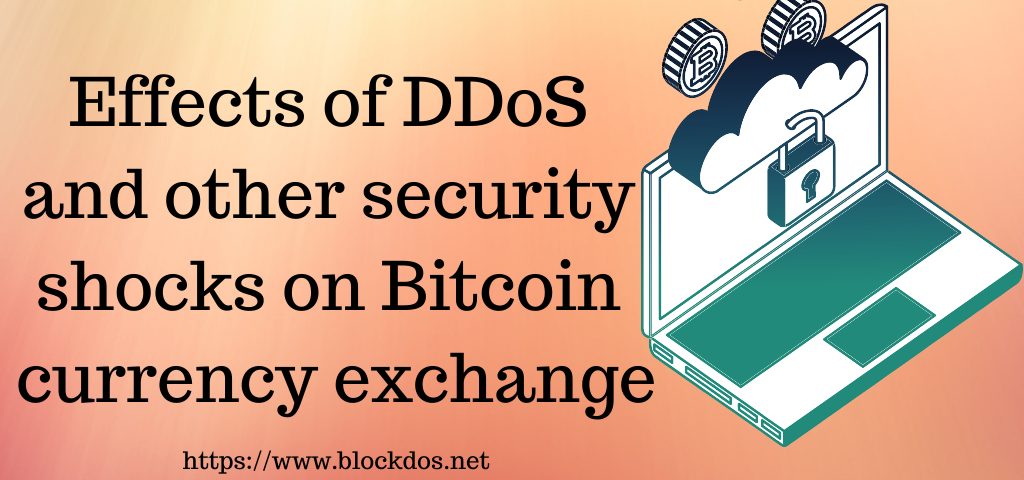Effects of DDoS and other security shocks on Bitcoin currency exchange

The recent increase in the number of digital currencies, driven by the launch of Bitcoin provides an incentive to quantify knowledge in 2009 Safety danger in a way that has always not been possible in other contexts. Cryptocurrencies to compete against other online payment systems, such as credit/debit cards and PayPal, as well as act as an alternative value store. They have been built with clarity in mind, creating a greater opportunity to measure risks. While Bitcoin’s architecture offers some protections against currency “counterfeiting,” in practice the ecosystem is vulnerable to cyber-criminal fraud, often targeting intermediaries such as wallets or exchanges. In this article, we analyze how one such danger, a distributed denial of service (DDoS) attack, affects the Bitcoin ecosystem. Although the denial of service attacks have been conducted on a wide variety of Bitcoin services, from gambling sites to mining pools, our investigation focuses on how DDoS attacks have affected the Mt. Gox exchange. We’re doing this for many reasons. First, prior research has shown that Mt. Gox is targeting DDoS free even more than any other Bitcoin operation. Second, DDoS attacks on currency exchanges have the potential to be both financially profitable and incredibly detrimental to its proponents: prohibiting anyone from buying or selling provides an unfair financial advantage for the attacker at the cost of ordinary participants. Third, after the crash of Mt. Gox, millions of transactions have been publicly revealed, providing a rare opportunity to measure the effect of DDoS attacks on trading.

World’s largest Cryptocurrency (bitcoin):
Bitcoin Cash (BCH) holds a significant position in the history of altcoins since it is one of the first and most popular hard forks of the original Bitcoin. A fork takes place in the cryptocurrency environment as a result of discussions and arguments between developers and miners. Owing to the decentralized existence of digital currencies, wholesale adjustments to the code underlying the token or coin at hand must be made on the basis of a general consensus; the method for this phase differs depending on the individual cryptocurrency. When various factions cannot come to an agreement, the digital currency is often divided, with the original chain staying true to its original code and the new chain starting life as a new version of the previous coin, along with changes to its code.
BCH started its existence in August 2017 as a result of one of these splits. The controversy that led to the development of BCH had to do with the question of scalability; the Bitcoin network has a block size limit: one megabyte (MB). BCH raises the block size from one MB to eight MB, with the assumption that larger blocks would accommodate more transactions within them, and thus the transaction speed can be increased. Other improvements are also made, including the elimination of the Segregated Witness protocol that affects block space. As of January 2021, BCH had a market cap of $8.9 billion and a value of $513.45 per token.
DDOS Attack on Digital currency (bitcoin):
Mt. Gox was by far the leading bitcoin exchange for much of the 2.5-year duration for which we have records. Although we can’t know for sure what inspired the spate of DDoS attacks on Bitcoin currency exchanges, there are a few possible reasons as to why someone would do that. First, there is substantial competition between currency exchanges and there is a high turnover in terms of which the platforms dominate but DDoS dedicated servers can avoid such attacks. Mt. Gox was the dominant exchange in 2011, with four new players taking over Mt. Gox in 2012 and 2013. While it cannot be concluded that the 34 confirmed DDoS attacks on Mt. Gox caused new entrants to lose market share, this remains a clear possibility, because frequent service interruptions could lead skeptical consumers to alternative platforms. Although there is no evidence that the new entrants were behind the DDoS attacks on Mt. Gox, they would definitely have benefited from doing so. The lawless nature of Bitcoin during this time, combined with dozens of new exchanges fighting for market share, may have led one or smaller exchanges to threaten their biggest rival.

Second, profit-driven traders could also conduct DDoS attacks to establish favorable trading conditions. This could happen both when prices increase and when prices fall. As prices rise, DDoS attacks could delay this increase by preventing traders who want to buy from being able to do so. For example, a trader who is trying to buy bitcoin on his way up could place a large order on a smaller exchange while blocking access to a larger Mt. Gox exchange. His lower bid will be accepted by sellers who are temporarily unable to sell on a larger site. Alternatively, if the attacker owns bitcoin, he may be able to ask for a higher price on a smaller exchange when the buyers are blocked from participating in Mt. Gox. As prices fall, DDoS attacks could slow down by restricting the completion of sales orders that push prices down. An attacker who holds Bitcoin, but is worried that its value could fall, might be tempted to launch a DDoS attack. So people are using DDoS proxy protection for security and Blockdos is providing protected servers and VPS for users to avoid DDoS attacks.
It is worth noting that even though these attacks do not have the desired result of artificially rising or decreasing prices as the perpetrators hope to do, they could still be launched with the belief that they could succeed. The low cost of launching DDoS attacks, combined with a very low risk of getting captured, may lead to miscreants experimenting with strategies regardless of whether or not they actually succeed in making money.
Trust and lack of faith in bitcoin exchange(because of DDOS):
Using an event study design, we find that following the DDoS attacks on Mt. Gox, there has been a substantial reduction in the number of major exchanges. In particular, the distribution of daily trading volumes becomes less distorted (fewer large trades) on the days following the DDoS attacks, that is why cheap DDoS protection is important for everyone. The findings are robust to alternative requirements and to limit the data to the duration of March 2013, i.e. the period before the high price appreciation of Bitcoin.
The issue is significant because exchanges are essential to the ecosystem of Bitcoin. In the exchanges, sellers benefit from a larger number of buyers, while buyers benefit from a larger number of sellers (so-called positive cross-side network effects). Exchange is an example of a marketplace; in order for an exchange to thrive, it must create trust among its users, as a lack of faith in exchange will easily lead to a downward spiral in which buyers and sellers quickly stop trading on the platform.
The cryptocurrency trading market is really lively. Exchanges perceived to be big players have changed dramatically over time. New ones have arisen, and old ones have been priced out of the market. The collapse of Mt. Gox in February 2014 demonstrated that even a large exchange might unexpectedly leave the market.
Transaction volume and large transactions:
A security shock raises the likelihood of a trade failure, and in certain recorded cases the value of the transaction can be lost. It would also seem rational for users to refrain from buying or selling bitcoins on an exchange after experiencing attacks. To assess the impact of these shocks on the Bitcoin ecosystem, we turn to transaction volume, the most common metric of user activity. We aggregate the daily transactions reported in the leaked data set of Mt. Gox and use this daily amount as our dependent variable. Since the finding is that there is a reduction in relatively large transactions after a DDoS attack, we may also use the highest daily transaction (denoted Max. Transaction) as an independent variable and check the weather for a significant shift on the day after the attack.
Endogeneity:
Since the data set is made up of regular aggregates in chronological order, we must deal with issues that may occur with the use of time-series data. Prior work has shown that attempted attacks are associated with the number of Bitcoins exchanged, and it is more likely the attacks would occur in times of high liquidity and a greater volume of transactions. This significant finding suggests that large trade levels will lead to an increased probability of DDoS attacks.
Conclusion:
In this blog, we performed the first econometric analysis evaluating the effect of DDoS attacks on Bitcoin currency exchanges. We collected evidence of confirmed DDoS attacks from two common Bitcoin discussion forums and found attacks targeting Mt. Gox on 37 days between April 2011 and November 2013. We also investigated the effect of 10 additional shocks impacting Mt. Gox over time, such as security breaches and unplanned outages. We have built a set of regressions to calculate the impact of shocks on the volume of transactions. Unfortunately, the direct use of the transaction volume as a dependent variable in regressions is problematic due to the problems of endogeneity and the increasing trend in the volume of transactions over time. And DDoS protection by blockdos can avoid such issues if people are using DDoS-protected VPS by blockdos.
